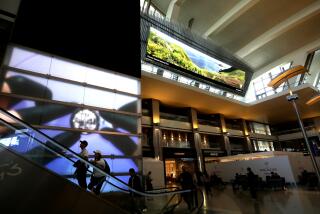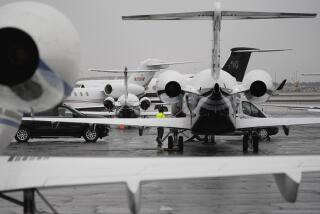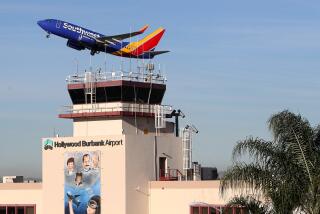Out of Arkansas Chicken Farms, Airport...
Imagine two of the longest airport runways in America, side by side. On one, a 747 carrying a full load of cargo is taxiing toward takeoff for Japan. Another 747 is jetting in from the Pacific Rim. Is this the new Denver airport? LAX?
Not quite. Right now it’s just a collection of chicken farms 70 miles off the nearest interstate in northwest Arkansas. But some of the country’s most powerful and politically connected families hope to transform this rural setting into a bustling airport that eventually could become a cargo gateway to Asia and fuel the local economy.
The airport’s biggest boosters are the Arkansas-based owners of the Wal-Mart Stores discount chain; Tyson Foods, the chicken giant; and J. B. Hunt Transport Services, the largest overland cargo hauler in the country.
So far the Federal Aviation Administration has provided $21 million in initial funding for the project, which would replace the under-equipped passenger airport in nearby Fayetteville. The first phase would cost $144 million for a terminal and a runaway that could accommodate commercial jetliners the sponsors say their growing region badly needs. They have not begun to estimate the cost of their ultimate plan, which would include two of the longest runways in America for cargo and passengers.
But the project’s critics--ranging from local farmers to airline experts--say chances are slim that this remote outpost in tiny Highfill, population about 100, can become the transportation hub its creators visualize. They see it as little more than pork-barrel politics at work, an illustration of how a dubious project gains steam when the right forces are behind it.
“Most of the people here have never been in a plane. Big business interests, that’s the only reason this is coming about,” said Jay Fulbright, nephew of the late senator J. W. Fulbright, who owns a farm near the site. “It’s a very powerful group of people. . . . It’s a very strange setup up here, because so much clout is concentrated with two or three families.”
With the most to gain from a mega-airport capable of handling overseas cargo, Tyson, Hunt and Wal-Mart took matters into their own hands to get the facility off the ground. In 1990, they created the Northwest Arkansas Regional Council. The council won support from the Democratic-controlled state legislature to create an airport authority that could condemn land and issue bonds.
The airport boosters also found officials in Washington who shared their sense of urgency. In 1990, the region’s longtime Republican congressman, John Paul Hammerschmidt, got 14 of his colleagues on the House Public Works and Transportation Committee to attend a field hearing on local transit needs. The witnesses featured Don Tyson, Wal-Mart founder Sam Walton and J. B. Hunt, the heads of the three companies.
“That was our drawing card,” Hammerschmidt recalled recently. Walton, a multimillionaire who died in 1992, reminded the elected officials that his company paid more than a billion dollars in taxes.
Two months later, Bush Administration Secretary of Transportation Samuel K. Skinner flew in with the news that his department had approved a $601,000 grant for an airport study, even before anybody had applied for one.
The study commissioned by the airport authority found that a new cargo facility would boost the local economy, allowing Tyson and other Arkansas poultry producers to ship by air and compete in the untapped market for fresh chicken in Japan. With competitive air freight rates, the study continued, Wal-Mart could bring in 10 747s a month filled with electronics and apparel from the Far East.
Jim Blair, general counsel for Tyson Foods and a close friend of then-Gov. Bill Clinton, urged local elected officials to get on board. Blair told the group that “there is an incredible chance to get $90 million from the federal government . . . ,” according to the Nov. 8, 1990, minutes of the elected board of Washington County.
At the same meeting, Uvalde Lindsey, a former aide to Gov. Clinton who now is staff director for the business group and the airport authority, justified the need by describing the region’s dramatic growth.
“The population center is going to move and, by the year 2010, will be close to Noel, Missouri, or possibly Winslow, Arkansas. By being the population center of America, what better place to build an airport?” he said. (Although northwest Arkansas’ population is growing at a rapid pace, the region is still relatively sparse, with 300,000 people.)
The FAA threw cold water on the plan for a cargo airport in 1991. Undeterred, the local airport backers shifted and emphasized the need for a new passenger airport to serve northwest Arkansas, including Springdale and Fayetteville.
Opponents and critics of a new airport agree something must be done to improve air service. Five percent of the 42 commuter flights a day into Fayetteville’s Drake Field are canceled because the airport does not have an instrument landing system and the mountainous terrain is often enveloped in fog.
But opponents argue that one of the local small airfields could be expanded or Drake Field upgraded, though that would require leveling off a mountain at the end of the runway. Even so, it would cost many millions less than building an airport, according to the airport authority and the FAA.
Federal aid was predicated on the closing of Drake Field. But Fayetteville city officials last fall dug in their heels to try to save Drake Field, which brings in about $40 million a year. Nevertheless, the FAA was opening the funding spigot to replace Drake Field with the new regional airport a short drive away.
Arkansas Democratic Sens. Dale Bumpers and David Pryor urged Transportation Secretary Frederico Pena to free up $9 million for airport land acquisition last fall. The senators credited White House senior adviser Thomas F. (Mack) McLarty with helping them get the funds. The FAA approved $12 million a few weeks ago for site development.
“We have been concerned about the lack of adequate airport capacity for some time,” said Paul Galis, the FAA’s deputy director of planning and programs. Drake Field does not have an instrument landing system and would be difficult to expand, he said.
After the completion of the passenger airport, the master plan calls for sponsors to go back to the FAA to seek funds to extend the 8,800-foot runway, and, if traffic is sufficient, eventually to seek funds for a second, 12,500-foot runway. The FAA is still a long way from buying into the airport backers’ ultimate goal: two huge parallel runways, each 12,500 feet long, which could handle cargo 747s bound for destinations overseas.
Michael J. Boyd, president of Aviation Systems Research Corp., a Colorado company that forecasts airport usage, has looked at the Arkansas proposal and said even the first phase is overly ambitious. “The airlines don’t want it; the traffic doesn’t support it,” Boyd said.
He agrees with Fulbright that the new airport is “a private-interest boondoggle. . . . Those are not cities that the Japanese are hankering to do business with.”
An article last month in Counterpunch, a Washington newsletter sponsored by the Institute for Policy Studies, christened the project “the Arkansas Poultryport.”
Blair, who said he had scaled back his involvement after “people began to say, ‘This is Tyson at work,’ ” said the idea that a few powerful companies have engineered an expensive boondoggle is “ridiculous.” He said Tyson has already abandoned any plans to export fresh chicken by air to Asia. “We tried it to France, and it was a disaster,” he said.
Noting that the federal government has provided huge sums for the new $4.9-billion Denver International Airport, Blair said, “A neglected area like this ought to get something.”
Meanwhile, air carriers say they are watching the airport plans cautiously. Air Transport Assn. spokesman Chris Chiames, whose organization represents airlines, said a new regional airport would drive up ticket costs. It costs airlines $3 per passenger to fly into Drake Field and the per-passenger cost at the new airport is projected as high as $15. “We don’t see the need for a passenger facility,” he said. “None of our members have indicated they want to sign up.”
Officials of Delta and American, two companies that airport boosters are counting on, say they are lukewarm to the idea.
“Realistically, at this time, we probably wouldn’t be looking at jets,” said American spokesman Tim Smith. “The market is better suited to American Eagle,” he said, referring to the airline’s commuter subsidiary that serves Drake Field.
Delta spokesman Todd Clay said it was premature to say whether his airline would offer service at the new airport. He warned that if costs run as high as recently projected and bump ticket prices up substantially, the passenger market could shrink. If that happened, the commuter carriers that serve the area would have to decide whether they wanted to stay in the northwest Arkansas market.
The FAA’s Galis said reaction from airlines has been generally favorable, although none has firmly committed to locate at the new facility. “Certainly we didn’t have anything signed in blood from any of the airlines,” he said. But Galis said the FAA expected a certain amount of caution at this point.
Airport defenders are convinced that concerns will be overcome as the new facility gets off the ground. “It’s just not a pork project,” Lindsey said recently. “We were in a position of strangling on our own growth.”
More to Read
Sign up for Essential California
The most important California stories and recommendations in your inbox every morning.
You may occasionally receive promotional content from the Los Angeles Times.










